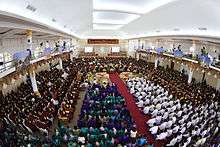Shwegyin Nikaya
Shwegyin Nikāya (Burmese: ရွှေကျင်နိကာယ, IPA: [ʃwèdʑɪ́ɴ nḭkàja̰], also spelt Shwekyin Nikāya) is the second largest monastic order of monks in Burma.[1] It is one of nine legally sanctioned monastic orders (nikāya) in the country, under the 1990 Law Concerning Sangha Organizations.[2] Shwegyin Nikaya is a more orthodox order than Thudhamma Nikaya, with respect to adherence to the Vinaya,[3] and its leadership is more centralized and hierarchical.[4] The head of the Shwegyin Nikaya is called the Sangha Sammuti (သံဃာသမ္မုတိ), whose authority on doctrine and religious practice is considered absolute (နိကာယဓိပတိ ဥက္ကဋ္ဌ မဟာနာယက ဓမ္မသေနာပတိ).[5]
ရွှေကျင်နိကာယ | |
| Abbreviation | Shwegyin |
|---|---|
| Formation | Mid-1800s |
| Type | Buddhist monastic order |
| Headquarters | Myanmar |
Members | 50,692 (2016) |
Key people | Shwegyin Sayadaw U Jāgara |

Statistics
According to 2016 statistics published by the State Sangha Maha Nayaka Committee, 50,692 monks belonged to this monastic order, representing 9.47% of all monks in the country, making it the second largest order after Thudhamma.[6] With respect to geographic representation, the plurality of Shwegyin monks live in Yangon Region (23.66%), followed by Sagaing Region (17.47%), Bago Region (16.58%), and Mandalay Region (13.98%).[6]
Origins
Shwegyin Nikaya was founded in the mid-nineteenth century by a chief abbot monk in the village of Shwegyin. It formally separated from the Thudhamma Nikaya during the reign of King Mindon Min, and attempts to reconcile the two sects by the last king of Burma, Thibaw Min, were unsuccessful.[1] Monks of the Shwegyin Nikaya did not participate in the nationalist and anti-colonial movement in British Burma of the early 1900s.
In the 1960s, with the ascent of Ne Win to power, the Shwegyin Nikaya gained monastic influence in the country, as Ne Win sought counsel from a monk at the Mahagandayon Monastery, a Shwegyin monastery in Amarapura.[7]
References
- "Archived copy". Archived from the original on 2008-12-17. Retrieved 2009-04-12.CS1 maint: archived copy as title (link)
- Gutter, Peter (2001). "Law and Religion in Burma" (PDF). Legal Issues on Burma Journal. Burma Legal Council (8): 10. Archived from the original (PDF) on March 14, 2012.
- Aung-Thwin, Michael (2009). "Of Monarchs, Monks, and Men: Religion and the State in Myanmar" (PDF). Working Paper Series No. 127. Asia Research Institute (18).
- Jordt, Ingrid (2007). Burma's mass lay meditation movement. Ohio University Press. p. 50. ISBN 978-0-89680-255-1.
- Carbine, Jason A (2011). Sons of the Buddha: Continuities and Ruptures in a Burmese Monastic Tradition. 50. Walter de Gruyter. ISBN 978-3-11-025409-9.
- Matthews, Bruce; Judith A. Nagata (1986). Religion, values, and development in Southeast Asia. Canadian Council for Southeast Asian Studies. Institute of Southeast Asian Studies. p. 61. ISBN 9789971988203.
